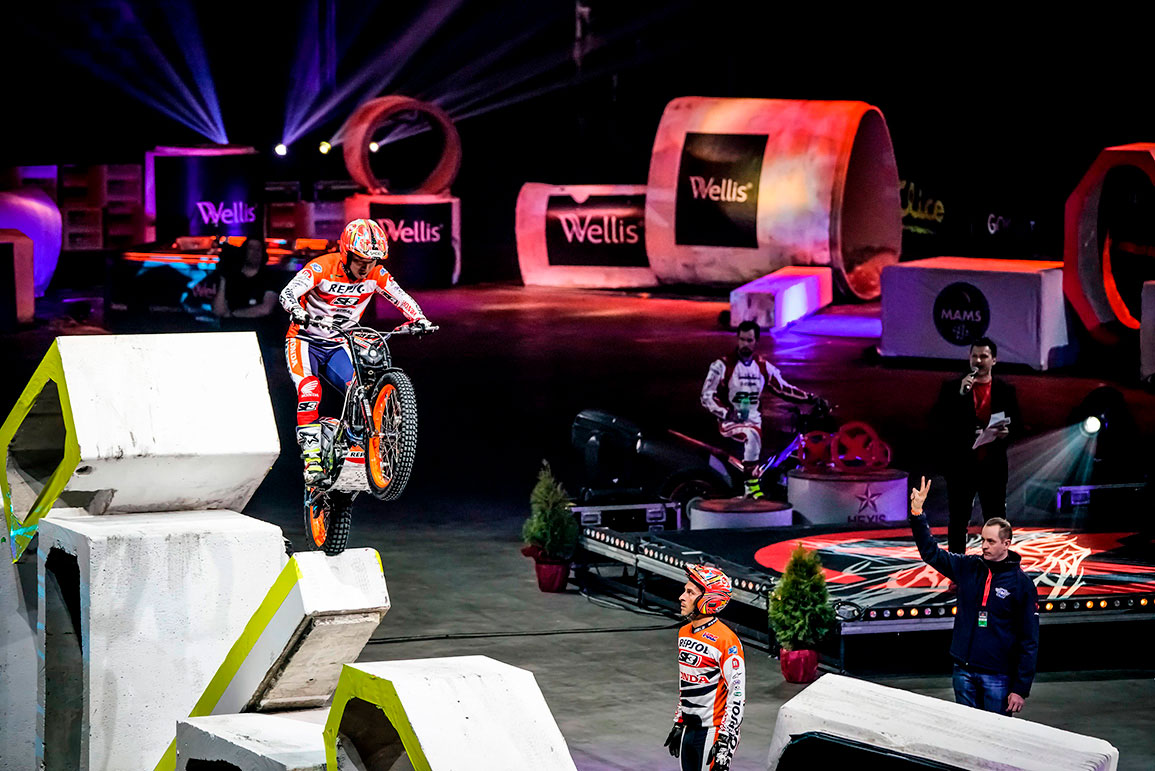In Trial, contrary to other disciplines like the Red Bull Air Race or MotoGP, riders gain points upon committing fouls. Therefore, the goal is to obtain the least amount of points while completing the marked path in the least amount of time.
Riders are penalised per section and can obtain a maximum of five points in each one. If a round were to have four sections, for example, a participant could accumulate up to 20 points for their mistakes. If the maximum time is exceeded for the round, an additional five points would be awarded. This maximum amount of time is determined by the number of sections and can be four, five, or six minutes long depending if there are four, five, or six sections.
Riders can commit two types of fouls: one point penalties, or penalties which immediately award them five points.


One point penalties
Riders can receive a one-point penalty when placing their foot on the ground, or footing. This penalty is applicable if any part of the rider’s body touches the ground or an obstacle, whether the bike is in motion or not.
The other reason for which a rider may receive a one-point penalty is if the bike leans. This happens when any part of the bike, except the wheels, leans and touches an obstacle, whether it is in motion or not. Under certain special circumstances, the mudguard may not be considered as an element that can cause this penalty.
A rider may commit up to three of these types of errors within one section, if they commit a fourth, five points will be directly awarded.


Five point penalties or “Fiascos”
This is the largest penalty that a trial rider can be subjected to without resulting in a suspension from the event. Fiascos entail an additional five-points and may be awarded for multiple reasons.
If at any point during the trial the rider backs up or gets off the bike, placing both feet on the same side of it, or behind the back axis, it is considered to be a “fiasco.”
If the rider crosses or breaches the lines that limit the stretch, if the bike crosses a door or limit on the wrong side, or if one is crossed with the rear wheel first, it will also be considered a “fiasco.”
The rider must avoid entering sections that are unauthorised or belonging to other categories, as well as breaking section support or markers if they wish to avoid penalties. They may not receive any external help to complete the obstacles or alter the conditions of the section.
The bike cannot pass over any marking that has been previously placed on the track, forming a loop, and cannot touch the ground with the handlebars. If the engine stops, the rider must react quickly, since footing or touching any obstacle with any part of the bike other than the wheels may incur a five-point penalty. The rider must also be connected to a circuit breaker while riding through the sections.
Entering a stretch incorrectly will also entail a five-point penalty.


Tie-break
If two or more riders are tied in the first round, the one who has made the best time will be ranked in the best placement. In the event all riders have exceeded the maximum time, victory would be awarded to the rider that started in first place.
In the second round, as in the first, the rider with the best time will be awarded the best placement, but in the event all riders have exceeded the allotted time, the first round’s placement will be taken into account.
In the final round, the riders will face a section chosen by the stewards and the winner will be the one with the least amount of penalties. In the event of a tie, the rider with the best time will be the winner, and if however, two or more riders were to finish within the same time, the second round’s placement will be taken into account.
Disqualification
Some infractions are so severe that they entail the rider’s immediate disqualification. This penalty is applicable only to actions that entail a security risk or flagrantly break the rules. Any disqualified rider will lose any result that may have been obtained in the event.
The riders can be disqualified for not wearing a helmet while riding.
Using unauthorised wheels or fuels or changing the wheel during the event, as well as refilling outside the paddock, are all causes for disqualification.
Breaking anti-doping rules is, naturally, a cause for immediate disqualification.
A bike that does not comply with the technical requirements, exceeds the permitted noise, or may be a risk for any other reason may not be used.
Displaying inappropriate behaviour with any official or organisation member is grounds for expulsion.


 Join Us
Join Us  Join Us
Join Us 